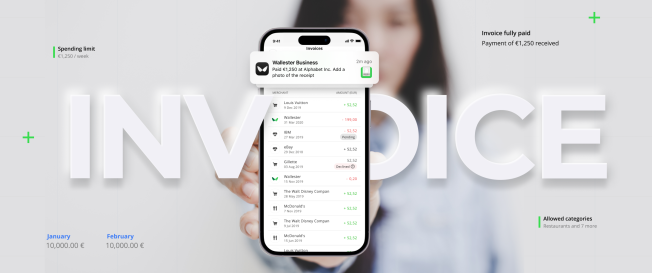Invoice payment terms are the contractually decided payment terms between a business and its customers. Invoice terms are also called payment terms when payments are due relative to the date on which goods or services were delivered or when the product or service’s invoice was delivered.
These invoice payment terms help the business predict when cash payments will start and when to start collection activities against customers who still haven’t paid. These terms differ from customer to customer as customers with big orders may demand longer payment terms. In contrast, more problematic customers may be required to make cash payments in advance or upon receipt of associated goods. Another way is to provide early payment discounts to motivate customers to pay the invoice amount within a short period.
How do invoice payment terms work?
Payment terms are essential for bargaining a contract. They are designed to maximise how quickly the customers pay you and minimise inconvenience for the client—a good set of payment terms benefits both parties involved. As the company starts invoicing customers, remember that your standard payment should match the goals of your large or small business. Choosing the right payment terms is crucial in establishing and maintaining a healthy business and seamless client relationship.
The Scheme of Invoice Payment Terms
To ensure that customers carefully follow invoice payment terms, a business can start collection activities instantly thereafter or impose a late fee with a few days grace period. Components of typical invoice payment terms include:
- Date of invoice
- The total due amount of the invoice
- The due date and time that the customer has to pay the owed amount
- Details of the payment plan
- Stipulations for a deposit or advance
- The currency the company wants to be paid in. If a company deals with international clients, it is essential to highlight the money used clearly
- Several accepted payment methods
A couple of other things should be included in the invoice, such as the invoice number that will enable the business and the customer to track invoices chronologically. Contact information of both parties should be clearly stated in case problems need to be solved immediately. The company can also indicate where the customer wants to send the invoice payment receipt. Invoices with payment terms generally outline when the organisation receives the money, and the invoicing system should benefit the company strategically.
Glossary of payment terms
There are numerous payment terms associated with invoice payments. Listed below are some of the most common payment terms that owners of small businesses should remember when preparing invoices.
- PIA: Payment in advance
- EOM: End of the month
- CND: Cash next delivery
- CBS: Cash before shipment
- CIA: Cash in advance
- CWO: Cash with order
- COD: Cash on delivery
- 1MD, 2MD: Monthly credit payment of a complete month or two months
- 21 MFI: 21st day of the month following the date of invoice
- Net 7, Net 10, Net 15, Net 30, Net 60, or Net 90: Payment expected within a week, 10 days, 15 days, 30 days, 60, or 90 days post the invoice date.
- Stage payments are pre-determined by the buyer and the seller and spread over time.
- Partial payment discount: This kind of discount is offered due to the company’s low cash flow.
- Contra: Payments the customer sends, balanced by the cost of the materials bought.
- Accumulation discounts: These types of discounts are paid on large orders.
- Forward dating involves an invoice payment once the customer has received the goods or services.
- 2/10 Net 30: Net 30 requires the customer to complete the payment within 30 days. However, under this method, if they pay their dues within 10 days, they will be subjected to a 2% discount. The terms are variable and will differ from one business to another. For example, the discount could be a whopping 5% if the client pays within seven days.
Why are payment terms important for your business?
Invoice payment terms are integral for a business since knowing how much money flows into the account and when is required for accurately making cash flow statements. When businesses thoroughly understand their cash inflows and outflows, they can plan their taxes and other expenses, helping the company run more smoothly. A detailed and well-made invoice can help the seller be sure that the buyer will pay on time. Communicating the terms of payments effectively will ensure that you and your clients know each other’s requirements before starting a business deal. Here are some statistics showing the importance of an optimum cash flow.
💡 Around 80% of small-scale businesses worry about their cash flow.
💡 Over 50% of small businesses with poor cash flow blame late customer payments.
💡 62% of small-scale businesses are unaware of how much money flows into the business every month.
💡 58% of business owners claim that the reason behind their poor decision-making was the result of cash flow problems.
Getting paid can be quite a big challenge for many businesses in the B2B sector since approximately 63% of industry sales are made on credit. This puts plenty of pressure on company owners and CFOs to find ways of funding their working capital. For this reason, it becomes critical for them to rely on payment terms to create a foreseeable schedule that will enable them to precisely calculate their cash flows. Knowing your monthly inflows can help a business significantly minimise various fiscal challenges and make room for improved budgeting, invoicing, and financial forecasting.
Simple Example of How Payment Terms Work
Organisations generally use standard terms of payment for daily transactions for credit-worthy clients. For instance, customers with monetary issues might be given the Cash in Advance (CIA) approach, Cash on Delivery (COD), or Payment in Advance (PIA) by the seller’s credit control department to avoid the risk of non-payment. A COD client pays through the delivery company when the bought items are finally delivered. The delivery company transfers payments to the company through direct deposit within 2 to 3 days.
To properly understand the mechanics of payment terms, here is an example. Imagine you have decided to open a small flower shop. You require raw materials and equipment totalling around $5,500. A customer gives you a big order of $6,000, estimated to be paid by the end of the month. Unfortunately, the customer fails to pay on time, pushing back your plan to buy the required equipment. This puts you in a tight spot – you have to pay rent for the flower shop despite not carrying out any business deals outside the location. You start losing money due to the late payment.
This example shows the importance of preparing well-timed invoice payments. Making a simple and precise invoice helps you receive timely payments, so you are never short on working capital. This allows you to maintain business operations while helping you meet your growth goals.
Common payment terms cases
Early Payment
Companies can offer their clients a motivator to pay early, such as providing a specific percentage of discounts if the customer pays the total amount before the due date.
50% Upfront
You may choose a partial payment of 50% of the total cost of a client’s purchase. Partial payments offer working capital a business might need to complete a customer’s order. They may also benefit the client by breaking costs into smaller parts, increasing sales and order value. If you go with the partial payment method, clearly define the due date of the remaining invoice and other important terms.
Prepayment
In this payment method, customers will be required to pay cash in advance for services. Advance payments help improve the company’s cash flow and minimise the risk of losing money. Suppose you have a small business, for example, a wedding photography or cake delivery business. In that case, you might want to avoid any cancellation risk by asking your customers to pay upfront. Some businesses give discounts to clients who pay in full.
Lines of Credit
Line of credit provides buyers credit toward the services and products they buy. Customers typically then repay the remaining amount on the agreed payment schedule. Large businesses generally use this method for customer financing.
Instalment agreements
Partial agreements are a common component of installment agreements, where the business breaks their clients’ payments into smaller parts to be paid over time. Instalment agreements and line-of-credit are similar, except that the former is entirely cash-based. Some organisations divide big projects into smaller milestones, and the client is expected to pay once each milestone is completed. A good rule is to implement these instalments based on every three months, let’s say when a particular part of the project is fully delivered.
Immediate payment (payment due upon receipt)
Also referred to as immediate payment, payment due upon receipt is a payment method for which payment is to be made as soon as the goods or services are delivered. These include payables upon receipt or cash on delivery. A company can bargain a clause into the contract, enabling it to repossess goods if the client is overdue.
Net 7, 10, 15, 30, 60, or 90
These terms demonstrate the number of days after which a payment is overdue. For example, N/10 or Net 10 implies that a client must pay their bill within 10 days of the date written on the invoice. So, if a Net 10 term is applied, and the invoice is dated 10 November, customers are liable to pay before 20 November. The best way to pick the proper Net payment term is by meeting your clients midway, a date that works for both parties.
Subscriptions and retainers
Retainer and subscription payment terms require clients to make regular payments within 10 and 30 days. Usually, businesses that use retainer agreements issue invoices to customers periodically.
How to control payment methods with payment terms efficiently?
Companies can use payment terms to control when and how their clients pay them. These terms set the general expectations on payment to avoid confusion or conflicts later. Here are a few tips to control payment methods with payment terms effectively.
The easiest way to determine your payment policies is by making the process crystal-clear and convenient for the customer. For example, if you are only used to accepting cash or cheque payments, broadening your line of payment methods may increase the possibility of timely payments.
Credit card payments
Credit card payments are easy and widely familiar in all parts of the world and can therefore encourage timely payments. You can ask clients to provide credit card numbers or accept payments through a mobile application. Credit card payments come with a certain fee, sometimes paid by the company and others by the client. If you choose the second option, you should clearly state that clause in the contract. It should be clearly stated that the customer will be charged a card fee if they pick this payment method.
Smart invoices
A range of software available allows clients to make online payments with a pay-enabled smart invoice. Thanks to these intelligent invoices, clients can use their automated clearing house, debit cards, and credit cards to process their bank transfers. Another way is by setting up automatic and recurrent payments, eliminating the uncertainty of invoicing. If you do not set up the option of recurring payments, you can directly email the invoices to the clients containing the payment link. These useful features will keep the client wary of deadlines and are ideal if you have uncompleted contracts.
What are the Most Common Payment Term Challenges among Small Businesses?
Creating a system of practical invoice payment terms is fundamental for safeguarding a company’s financial interests but is not free of challenges. Below are some of the issues small businesses face and ways to overcome.
Unpaid invoices
Small businesses are seriously hit by overdue payments, many of which halt their operations. To ensure the smooth running of a business, it is essential to set up comprehensive payment guidelines and terms for payments past the deadline. Additionally, adding penalties for late payments can help deter clients from going overboard on the deadline and paying sooner than the required date. Earlier payment collections and invoice factoring are other ways to avoid unpaid invoices. Invoice factoring is when businesses hand over their invoice to an invoice factoring company which employs different tactics to retrieve the payment from the customer. The company then takes a certain percentage of the amount received plus a fee.
Payment Security
Online payments are ever-advancing, and with that comes the introduction of an array of payment platforms. However, not all media and means of transferring amounts are secure and trustworthy. To stay on the safe side, it is best to pick a platform that is well-reputed and known for providing maximum security and excellent customer service in case a security breach occurs. Estimating and invoicing software with combined payment channels and other gateways can help a company win the trust of its clients.
Managing payments and invoices
For some businesses, size can be a significant detrimental factor that might pose problems dividing the money among different departments. An excellent way to overcome this problem is by using invoicing software that will not only create invoices but also enable companies to add their invoice payment terms.
How to Set Late Fees For Unpaid Invoices?
Before you set a late fee for unpaid invoices, it is essential to properly decide the penalty rate and then precisely draft it in the contract. This s done by negotiating your payment terms with the clients before a project begins. It is best to work alongside them to find the perfect approach to benefit both sides rather than just one. Once a mutual decision has been made, highlight the terms in the contract.
Defining and listing your terms clearly will give you a legal edge if the customer does not abide by the rules. If payments are late and the client ignores the deadline repeatedly, you will be in a position to take legal action to retrieve the payment. An invoice is not a legally-binding document, but a contract is. So, you must create a detailed contract that doesn’t list all the payment terms to have legal standing in court. You can include a range of penalties for late payments. For example, you can add fees for EOM, non-payments, or Net 10.
Remember that a late payment penalty is not to generate revenue but to push your client into paying on time. For this reason, the penalty fee should not be too high, or your client may start looking for a seller elsewhere. A reasonable rate for a late fee is 1.5% interest per month, which is sufficient for incentivising appropriate behaviour without leaving the client feeling exploited. If you don’t get paid, send another invoice, including the original cost and the late fee. Attach a polite note, such as “Second Notice – 15 days past the deadline”. Continue following up with the client until you have received the money or determined a payment plan.
Besides adding penalties, sending your clients invoices when you provide the goods or services is critical. Any delay might cause cash flow problems in future payments.
How to Choose the Best Invoice Terms for Your Business?
Choosing the ideal payment terms for your business is essential since it helps regulate the cash flow and influences the clients’ payment habits. Listed below are a few things to consider before establishing your terms.
👉 Cash Flow
Even though customer expectations are essential when creating invoice payment terms, your primary consideration should be the company’s cash flow needs. The ideal invoice payment system provides sufficient liquid cash for your business to keep running smoothly while considering your clients’ needs closely.
👉 Industry Considerations
Knowing the industry standards is also essential before choosing payment terms. The Net 30 is the most common term, but it might not necessarily be standard in your industry. For example, in the landscaping sector, the norm is Net 7, whereas, in the construction industry, the most common term is Net 90.
👉 Client’s History
If you have a returning client, you can base the invoice terms depending on your experience with them. Are they reasonably prompt with their payments, or do they well past the deadline? The answer will help you decide whether or not you should keep things as they are or lengthen/shorten the payment deadline.
👉 Invoice Size
Always take into account the invoice amount. The smaller the amount, the less time you need to chase after it. Larger payments require extended deadlines so the customer has enough funds to finance the ongoing project. A good rule is to ask the client for an upfront deposit if you are dealing with a large project, as this will help cut down the risk of non-payment.
👉 Early Payment Discounts
These discounts act as a reward for customers to pay before the due date and help your company meet its financial obligations. Most invoices paid after a month or more are generally coupled with early payment discounts. Not only does this help you receive payments quicker, but it also creates a sense of trust between you and your clients.
The Bottom Line
Establishing invoice payment terms requires careful consideration of your company and the clientele. These payment terms prioritise account receivables and create expectations for your clients, strengthening the relationship and making business operations more seamless. With the right tools and techniques, your company, too, can stay on top of the cash flows and avoid financial risks.
We would be delighted to meet with you, discuss your business case, and explore how we can be of assistance.
Don’t hesitate to reach out to us through this contact form.
Our team is always happy to help you in any way we can.


